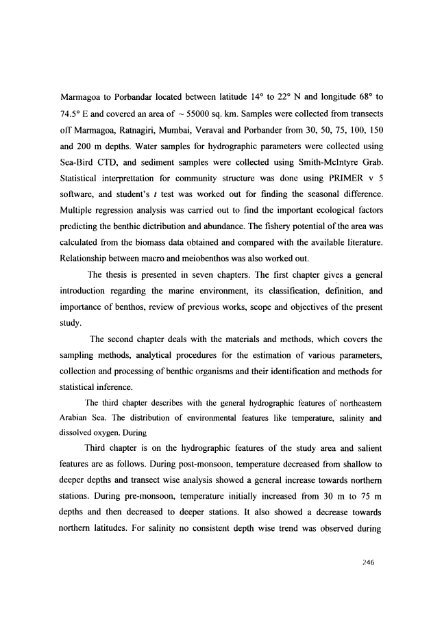L - Cochin University of Science and Technology
L - Cochin University of Science and Technology
L - Cochin University of Science and Technology
You also want an ePaper? Increase the reach of your titles
YUMPU automatically turns print PDFs into web optimized ePapers that Google loves.
Mannagoa to Porb<strong>and</strong>ar located between latitude 14° to 22° N <strong>and</strong> longitude 68° to<br />
74.5° E <strong>and</strong> covered an area <strong>of</strong> - 55000 sq. km. Samples were collected from transects<br />
<strong>of</strong>f Mannagoa, Ratnagiri, Mumbai, Veraval <strong>and</strong> Porb<strong>and</strong>er from 30, 50, 75, 100, 150<br />
<strong>and</strong> 200 m depths. Water samples for hydrographic parameters were collected using<br />
Sea-Bird CTD, <strong>and</strong> sediment samples were collected using Smith-McIntyre Grab.<br />
Statistical interprettation for community structure was done using PRIMER v 5<br />
s<strong>of</strong>tware, <strong>and</strong> student's t test was worked out for finding the seasonal difference.<br />
Multiple regression analysis was carried out to find the important ecological factors<br />
predicting the benthie dictribution <strong>and</strong> abundance. The fishery potential <strong>of</strong> the area was<br />
calculated from the biomass data obtained <strong>and</strong> compared with the available literature.<br />
Relationship between macro <strong>and</strong> meiobenthos was also worked out.<br />
The thesis is presented in seven chapters. The first chapter gives a general<br />
introduction regarding the marine environment, its classification, definition, <strong>and</strong><br />
importance <strong>of</strong> benthos, review <strong>of</strong> previous works, scope <strong>and</strong> objectives <strong>of</strong> the present<br />
study.<br />
The second chapter deals with the materials <strong>and</strong> methods, which covers the<br />
sampling methods, analytical procedures for the estimation <strong>of</strong> various parameters,<br />
collection <strong>and</strong> processing <strong>of</strong> benthic organisms <strong>and</strong> their identification <strong>and</strong> methods for<br />
statistical inference.<br />
The third chapter describes with the general hydrographic features <strong>of</strong> northeastern<br />
Arabian Sea. The distribution <strong>of</strong> environmental features like temperature, salinity <strong>and</strong><br />
dissolved oxygen. During<br />
Third chapter is on the hydrographic features <strong>of</strong> the study area <strong>and</strong> salient<br />
features are as follows. During post-monsoon, temperature decreased from shallow to<br />
deeper depths <strong>and</strong> transect wise analysis showed a general increase towards northern<br />
stations. During pre-monsoon, temperature initially increased from 30 m to 75 m<br />
depths <strong>and</strong> then decreased to deeper stations. It also showed a decrease towards<br />
northern latitudes. For salinity no consistent depth wise trend was observed during<br />
l46

















